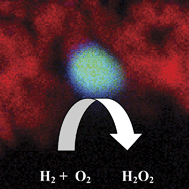Au–Pd supported nanocrystals as catalysts for the direct synthesis of hydrogen peroxide from H2 and O2†
Abstract
The direct synthesis of

- This article is part of the themed collection: Green and sustainable chemistry
* Corresponding authors
a
School of Chemistry, Cardiff University, Main Building, Park Place, Cardiff, UK
E-mail:
hutch@cardiff.ac.uk
Fax: +44 29 2087 4030
Tel: +44 29 2087 4805
b Center for Advanced Materials and Nanotechnology, Lehigh University, 5 East Packer Avenue, Bethlehem, PA 18015-3195, USA
The direct synthesis of

 Please wait while we load your content...
Something went wrong. Try again?
Please wait while we load your content...
Something went wrong. Try again?
J. K. Edwards, A. Thomas, A. F. Carley, A. A. Herzing, C. J. Kiely and G. J. Hutchings, Green Chem., 2008, 10, 388 DOI: 10.1039/B714553P
To request permission to reproduce material from this article, please go to the Copyright Clearance Center request page.
If you are an author contributing to an RSC publication, you do not need to request permission provided correct acknowledgement is given.
If you are the author of this article, you do not need to request permission to reproduce figures and diagrams provided correct acknowledgement is given. If you want to reproduce the whole article in a third-party publication (excluding your thesis/dissertation for which permission is not required) please go to the Copyright Clearance Center request page.
Read more about how to correctly acknowledge RSC content.
 Fetching data from CrossRef.
Fetching data from CrossRef.
This may take some time to load.
Loading related content
